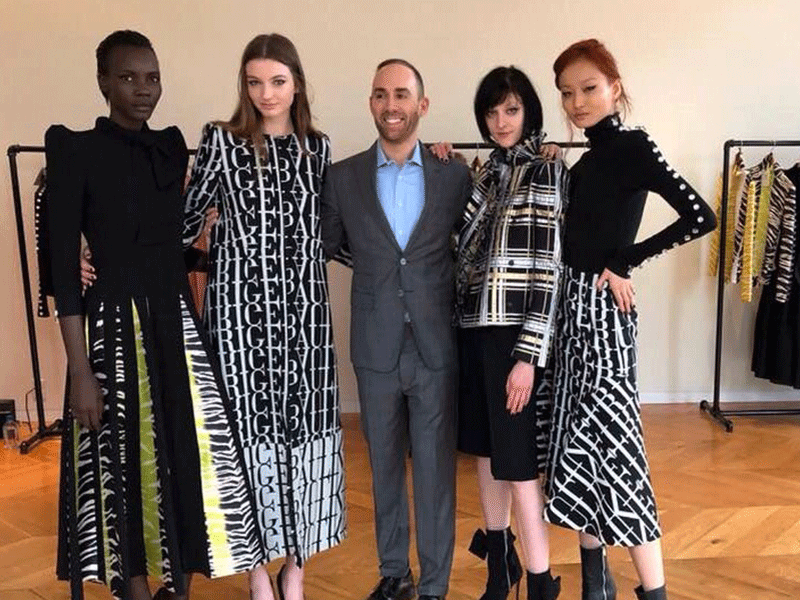The New York Times called her the “exemplar of American style,” after Paris-born fashion designer Pauline Trigère died in 2002 at the age of 93.
For a half-century, this Jewish refugee, a trailblazing female entrepreneur, created women’s clothing that epitomized both elegance and boldness.
Trigère worked until the end of her life, refusing to relinquish control of the house she built almost single-handedly. After her death, the brand became dormant, but did not disappear, because her son, Philippe Radley, a lawyer specializing in intellectual property, knew its value.
READ: ARE THERE ANY TRICKS TO FINDING MR. (OR MRS.) RIGHT?
Many offered to buy the label, but Philippe Radley and his brother, Jean-Pierre Radley, refused, believing these pretenders would not do justice to their mother’s legacy.
That was, until Franklin Elman, a native Montrealer and a designer who has been building a reputation in Europe for close to 20 years, was entrusted with creating a new Trigère prêt-à-porter collection. The unveiling of his first 80-piece wardrobe in New York last month has the fashion world abuzz. Vogue even gave it a 36-photo spread.
Milan-based Elman, 46, has been designing shoes since he headed to Italy in the late 1990s with “a portfolio of drawings and a dream.”
The prominently philanthropic Lewis family of Montreal has backed his bid to revive the Trigère label. As creative director, Elman is the face of the reborn brand and produced the collection almost entirely on his own.
“I’m stepping into very large shoes,” he said. “Pauline Trigère was a master; I am simply the student.”
Elman, a Bialik High School graduate, became interested in women’s fashion in his early teens, when he was captivated by a magazine photo. He never thought designing clothes could be a profession and his parents encouraged him to seek a more practical career.
“I thought about architecture, but I didn’t (have the) math skills,” he said during a recent trip to Montreal to visit family.
After attending Marianopolis College, Elman left Montreal to study at the top-ranked Rhode Island School of Design and graduated with a fine arts degree.
While living in New York, he met Donna Karan designer Bonnie Young, who opened doors for him in Italy, the world capital of haute shoe design. After a week of interviews, he landed a one-year contract at a house near Venice.
“For years, I was the only designer who was not Italian or French,” he said.
Over the past 18 years, he has been a consultant to prestigious fashion houses and shuttles regularly to Paris and London.
Elman’s task was not to imitate, or even update, the styles that distinguished Trigère, but rather to reinterpret them.
“There is a lot of contrast: timelessness and avant-garde, bourgeois and radical, masculine and feminine, black and white,” he said.
Trigère knew how to drape and construct, working directly with fabric rather than on a drawing board, which gave her clothes a sculptural look.
One piece Elman has kept almost unchanged is Trigère’s famous 1973 coat with a Cubist-inspired “Pauline Trigère” monogram all over it.
Although he knew of Trigère, before his first sketch, Elman set about to learn as much as he could about the legendary couturière, whose archives are held by Brandeis University.
He is acutely aware of the gravity of the responsibility he has assumed.
Trigère was a prodigy who learned her craft from her Russian dressmaking parents. Fearing the Nazis, Trigère, her Russian immigrant husband, a tailor, their two toddler sons and her widowed mother fled France for Argentina in 1937. New York enchanted her during a stopover and they stayed.
The marriage soon ended. To support her family, Trigère founded her fashion house in 1942 and soon was doing a million dollars in annual sales.
Clients included the likes of Elizabeth Taylor, Jackie Onassis and Evelyn Lauder.
Elman also admires Trigère because, in 1961, she was the first designer to hire a black model, Beverly Valdes, which lost her many Southern clients. “She said, ‘Let them go.’ It wasn’t a political or moral statement. (Race) was just not an issue for her,” he said.
Elman has, in a sense, become her heir. Trigère’s sons both died in recent years.
“A lot of speculators and pirates over the years tried to buy the brand, but her sons were very sensitive to protecting and preserving their mother’s name and what she accomplished,” said Elman.
“She was unique, hers was the only American brand of its kind and her house was around before Dior, Balmain and Givenchy.”
Elman is now working on a second collection that is set to be released in September. Will Trigère be in Montreal shops any time soon?
“I’m not holding my breath,” he admits. Like the line’s main competitors – Céline, Chloé and Givenchy – it will likely only be sold in the fashion capitals of the world.
